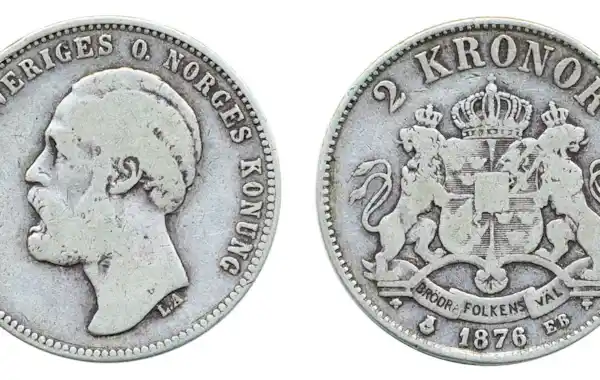02 January 2024
|
In his latest guide to collecting coins, Michael Burzan examines the krona currency of King Oscar II, who was the last king of both Sweden and Norway.
Over 150 years have passed, since the Swedish Riksbank introduced the krona (crown) as a new unit of coinage after implementing the gold standard in 1873.
In the same year, on 12 May, Oscar II (1829–1907) had been crowned as king of Sweden and Norway, after the death of his brother, King Charles XV of Sweden, and of Charles IV of Norway in 1872. In 1905, the two countries were separated.
The birth of the Krona
The gold standard meant that a certain amount of gold had a set price in the country’s currency. The krona thereby got a fixed exchange rate against the other currencies participating in the system.
The name of the new coinage unit, the krona, came from France via Denmark. A krona was the equivalent of 0.403225g of gold. Under the framework of the gold standard, Denmark and Norway also adopted the krona and øre as national currencies.
Read more auction updates, price guides, and collecting advice in every issue of Coin Collector.
Find out more and subscribe to the popular magazine today!
The first Swedish currency valued at 1 krona was a black and green banknote. It was printed on one side with the lettering ‘Sweriges Riksbank inlöser, vid anfordran, denna sedel å En Krona med guldmynt enligt lagen om rikets mynt af den 30 Mai 1873’ (...will pay, on demand, for this note one krona in gold coin according to the law on the national coinage of 30 May 1873).
A total of €70 was asked for an 1874 1-krona note at Myntkompaniet, while €44 was asked for a not folded example from 1875 with minor foxing. From 1875, 1-krona coins were also minted.
Golden crowns
The first Swedish gold coins in crown nominals as currency under King Oscar II of Sweden and Norway dated 1873 were the 10 kronor (1873–76, diameter of 18mm, 4.4803g of 900 gold, bullion value over €200) and the 20 kronor (1873–76, diameter of 23mm, 8.9606g of 900 gold).
The reverse shows the royal coat of arms within a crowned mantle and mintmarks. Above, we find the king’s motto ‘BRÖDRAFOLKENS VÄL’ (‘for the welfare of the brother peoples’).
For the 20 kronor, the first mintage of 1873 was 115,108 pieces. Rarest is the last year 1876 with only 25,750 minted, which may achieve double prices. Bids from €450 were invited for a 1874 20 kronor with a double cut of the ‘4’ in the year (Teutoburger).
In comparison, there is a slightly higher price, from €500, for the golden 1875 20 kronor/5 specie-daler of Norway in above average condition, with results of up to 6,000 Norwegian kronor (c.€540).
2 kronor variants
Sweden’s first version of the 2-kronor coins with Oscar II (titled ‘SVERIGES O. NORGES’) was minted in 1876–80 in silver (.800) with a weight of 15g, and it is 31mm in diameter and 2.17mm thick. On the reverse, under the crowned coat of arms held with the king’s motto on a scroll, we find the year date with mintmarks at sides.
On the 2-kronor coins from their first year of 1876, three types can be found, which are easy to recognise.
The usual type 1 carries a smaller year date, which is 5mm wide. Rarer are type 2, with a large date (6mm wide) and a large ‘E.B.’, and type 3, which has a large date (6mm) and short ‘E.B.’ (Figure 6). Numista estimates the frequency of type 2 and 3 at only round 6% each.
In 1878, a scarce variety was produced that had ‘OCH’ (and) between the two countries above the king’s head.
Once Norway had gained its independence, 2-kronor coins were issued with the inscription of ‘OSCAR II SVERIGES KONUNG’, indicating that King Oscar II was just king of Sweden. The king died on 8 December 1907.













